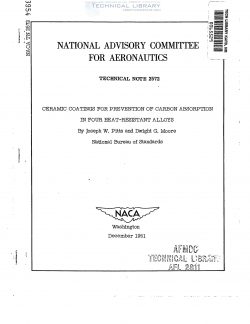naca-tn-2572
- Version
- 108 Downloads
- 556.60 KB File Size
- 1 File Count
- December 16, 2016 Create Date
- December 16, 2016 Last Updated
National Advisory Committee for Aeronautics, Technical Notes - Ceramic Coatings for Prevention of Carbon Absorption in Four Heat Resistant Alloys

Stabilized stainless steels, when used in aircraft exhaust systems
under severe operating conditions, have been shown to undergo carbon
absorption with a resulting carbide precipitation at or near grain
boundaries. Failures of exhaust parts have been ascribed to this cause
and the prevention of the carbon absorption is therefore desirable.
In the present investigation, three ceramic coatings were applied
to four heat-resistant alloys and then tested for their effectiveness
in preventing carbon absorption under strongly carburizing conditions,
that is, box carburizing. At 13500 F no carbon pickup occurred after
the 1+-hour treatment but at 15000 and 16500 F carbide precipitation was
evident in the uncoated stabilized 18-8 steels extending down from the
surface to a depth of as great as 0.007 inch. In most cases the ceramic
coatings completely prevented the‘absorption.
Inconel showed no evidence of carbon absorption under the test
conditions used.
In recent years ceramic coatings have been used with success for
the protection of aircraft-exhaust-system alloys. The primary purpose
of the coatings is to retard the deterioration of the alloys by the
various corrosive agents present in the exhaust gases.
According to Heron, Harder, and Nestor (reference 1) the most
important of these corrosive agents present in the gases from internal
combustion engines are lead compounds, oxygen, hydrocarbons, carbon
monoxide, and free carbon. Earlier studies by the National Bureau of
Standards have demonstrated the ability of/ceramic coatings to protect
alloys from oxygen (references 2 and 3) and lead bromide (reference A)
but there have been no studies reported relative to the effectiveness
of the coatings in preventing carbon penetration.
Carbon penetration occurs when heat-resistant alloys are operated
at high temperatures in the presence of carbon monoxide, carbon, or
some of the hydrocarbons. That carbon is absorbed during operation of
stabilized 18-8 stainless-steel aircraft exhaust systems has been
demonstrated by Kahn, Oster, and wachtell (reference 5) and by Hubbell
(reference 6). The absorption is followed by carbide precipitation at
grain boundaries and, according to reference 5, this carbide precipita-
tion may be responsible for many of the failures in stainless—steel
exhaust systems.
| File | Action |
|---|---|
| naca-tn-2572 Ceramic Coatings for Prevention of Carbon Absorption in Four Heat Resistant Alloys.pdf | Download |

Comment On This Post